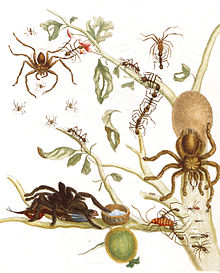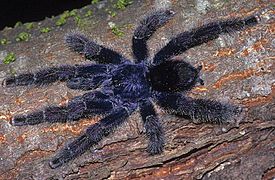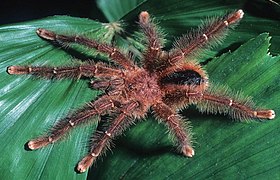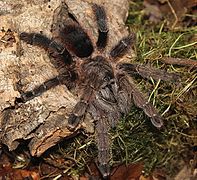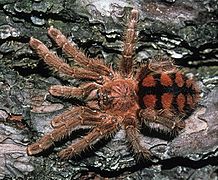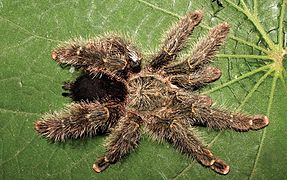
Brachypelma is a genus of spiders in the family Theraphosidae (tarantulas). They may have bodies up to 6 cm long with legs of similar or greater lengths. Some species have brightly colored legs, with red or orange marks and rings.
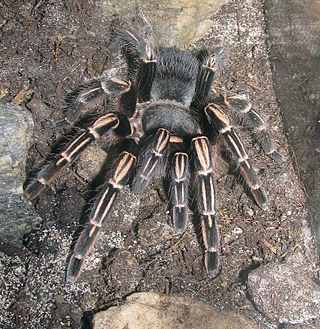
Aphonopelma is a genus of tarantulas native to the Americas. It includes nearly all the North American tarantula species north of Mexico and a considerable percentage of the tarantula species that range into Central America. Most are fairly large tarantulas with leg spans of 6 in (16 cm) or more. Like most New World tarantulas, all species of Aphonopelma have urticating hairs. Despite their fearsome appearance, these tarantulas are not harmful to humans and some species are popular in the pet trade. With about 90 species described so far, Aphonopelma comprises about 10% of the total number of described tarantula species. However, their taxonomy is poorly understood and species are difficult to tell apart, especially those that are brown or black without other pattern. Therefore, the actual number of species is unknown, with more species likely to be identified in the near future. In captivity, they are usually fed crickets; in the wild, they eat most insects, including crickets, grasshoppers, cockroaches, mantises, and beetles.

The Antilles pinktoe tarantula, also known as the Martinique red tree spider or the Martinique pinktoe, is popular as a pet spider because of its docile character and unique coloration.
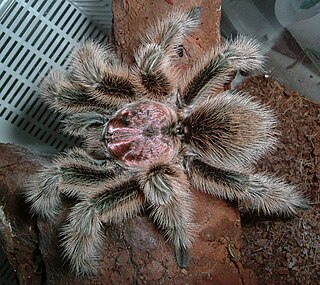
Grammostola is a genus of South American tarantulas that was first described in text by Eugène Louis Simon in 1892. These medium- to large-sized spiders are native to tropical South America, and are usually brown in color, with pinkish or orangish-red hairs. The very docile Chilean rose tarantula is popular as a beginner's spider among tarantula enthusiasts.
Cândido Firmino de Mello-Leitão was a Brazilian zoologist who is considered the founder of Arachnology in South America, publishing 198 papers on the taxonomy of Arachnida. He was also involved with education, writing high-school textbooks, and contributed to biogeography, with essays on the distribution of Arachnida in the South American continent.

Pamphobeteus is a genus of tarantulas that was first described by Reginald Innes Pocock in 1901. It includes some of the largest spiders in the world. They are found in South America, including the countries of Peru, Bolivia, Ecuador, Brazil, Colombia and Panama.
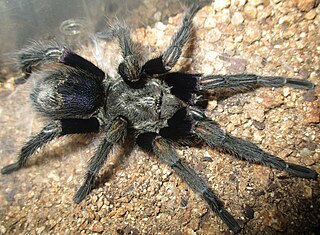
Euathlus is a genus of South American tarantulas that was first described by Anton Ausserer in 1875. These spiders are medium sized and are usually found in high elevations in the Andes. It is a senior synonym of Paraphysa, and was formerly considered a senior synonym of Brachypelma, but this was later rejected.

Tarantulas comprise a group of large and often hairy spiders of the family Theraphosidae. As of December 2023, 1,100 species have been identified, with 166 genera. The term "tarantula" is usually used to describe members of the family Theraphosidae, although many other members of the same infraorder (Mygalomorphae) are commonly referred to as "tarantulas" or "false tarantulas". Some of the more common species have become popular in the exotic pet trade. Many New World species kept as pets have setae known as urticating hairs that can cause irritation to the skin, and in extreme cases, cause damage to the eyes.
Grammostola anthracina is a species of spider belonging to the family Theraphosidae (tarantulas). It is found in Uruguay, Paraguay, Brazil, and Argentina.

Iridopelma is a genus of Brazilian tarantulas that was first described by Reginald Innes Pocock in 1901.

Tapinauchenius is a genus of tarantulas that was first described by Anton Ausserer in 1871. The name is a combination of the Greek ταπεινός, meaning "low", and αὐχήν, meaning "neck". In 2022, the genus Pseudoclamoris was transferred to Tapinauchenius.

The Aviculariinae are a subfamily of spiders in the family Theraphosidae (tarantulas). They can be distinguished from other theraphosids by a number of characters. Their legs have no or few spines on the underside of the tibial and metatarsal joints of the legs. The last two leg joints have brushes of hairs (scopulae) that extend sideways, particularly on the front legs, giving them a spoon-like (spatulate) appearance. Females have two completely separated spermathecae.

Acanthoscurria is a genus of tarantulas that was first described by Anton Ausserer in 1871. They are found throughout South America including the countries of Argentina, Bolivia, Brazil, Ecuador, French Guiana, Guyana, Paraguay, Peru, Suriname and Venezuela, plus into the Windward Islands West Indies,.

Typhochlaena seladonia is a species of aviculariine tarantula, and is the type species of the genus Typhochlaena. It is unique as an arboreal spider that constructs trapdoors in the bark of trees.

Sericopelma is a genus of tarantula, found in Central America from Nicaragua to Panama. The limits of the genus and its distribution have long been confused; it is closely related to the genus Aphonopelma. Sericopelma species are among the largest found in Central America. They can be kept as pets, although at least one species has been described as "very aggressive".

Lasiodora is a genus of tarantulas that was first described by Ludwig Carl Christian Koch in 1850. They are often very large; body lengths of up to 25 centimetres (9.8 in), including the legs, are not unusual.

Caribena is a genus of spiders in the family Theraphosidae (tarantulas), found in the Antilles. The two species accepted as of March 2017 were formerly placed in Avicularia. Apart from a different distribution – Avicularia species are found in mainland South and Central America – Caribena is distinguished by having longer and thinner type II urticating hairs in a conspicuous patch on the upper surface of the abdomen. Males also have a differently shaped palpal bulb.

Ybyrapora is a genus of spiders in the family Theraphosidae (tarantulas), found in Brazil. Its species were formerly placed in the genus Avicularia.

Avicularia juruensis is a species of spider in the family Theraphosidae, found in South America. Avicularia urticans was brought into synonymy in 2017. It has been given the English name Amazonian pink toe spider. Under the synonym Avicularia urticans, it is also known as the Peruvian pinktoe tarantula. It is a large mygalomorph spider, with a maximum body length over 30 mm (1.2 in) and the longest fully extended leg about 60 mm (2.4 in). Like other species in the genus Avicularia, specimens under this name are sold as pets, although their identity has not been confirmed by taxonomic studies.

